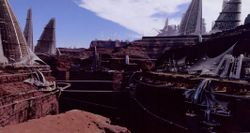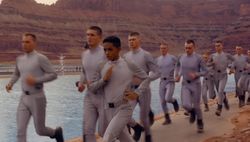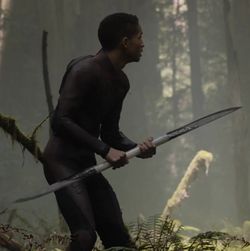United Ranger Corp (After Earth)
The United Ranger Corp is a military organization that features in After Earth.
Contents[hide] |
History
The United Ranger Corp was a Human established organization created when mankind had lived on Earth. During that time, the planet had been devastated due to the population leading to environmental disasters impacting its surface. At its height, the Rangers were founded one thousand years ago as part of a global military effort that involved the evacuation of the planet. After departure, the United Ranger Corp led the efforts of humanity's departure into space and eventual colonization of a new homeworld designated as Nova Prime located in the Nova Solar system. This period of history was not without incident as mankind made its first encounter with an alien race where hostilities were declared by the extraterrestrial foe. During the conflict, the aliens unleashed the Ursa as living weapons who were bred to kill humans. Humanity once again faced extinction but this time at the hands of an alien foe and turned once more to the Rangers for salvation. This salvation came in the form of Cypher Raige who was fearless to the point that the fear sensing Ursa could not detect him leading to an eventual victory. The victory, however, came at the cost of many losses which included Cypher's daughter Senshi. Despite these losses, mankind prevailed and the Rangers continued their protection of humanity with a number of Ursa's kept alive for training purposes. By this point, humanity had made a number of colonies in addition to Nova Prime that included Ipitos and an anchorage point at Lycia. General Cypher Raige ultimately decided to retire from active service but wanted to be involved in a final supervisory training mission that involved the delivery of an Ursa to the training facility at Ipitos. On this mission, he took his son Kitai where they travelled onboard the transport Hesper 2-9-9 with the creature secured in cargo storage. However, during the travel, the ship encountered an asteroid storm that Raige managed to determine from the higher graviton count with the vessel being damaged by the impacts. This led to an emergency wormhole travel where the ship accidently emerged in the Sol system around Earth that had been under class one quarantine by the interplanetary authority. Though unwilling to land, General Raige had no choice as the transport was badly damaged which necessitated an emergency landing despite it being an offense to land on the planet. During re-entry, the damaged section ripped the ship apart causing it to crash leading to General Raige and his son being the only human survivors whilst the Ursa managed to also survive where it fled into the wilderness. An earlier attempt by the pilots to send a distress signal failed to be detected forcing Kitai to try to launch an emergency beacon on Earth's surface where he had to accomplish the task himself as his father Cypher had been wounded preventing him from conducting the task himself. As a result, the Ranger provided remote assistance to his son in order to help in their survival on the hostile world.
Overview
Training and tests were used during the training of cadets where they were assessed by commanders. Commanders were responsible for determining not only their simulated scores but whether they could serve practically as a Ranger. Those failing the practical requirements in the finals were withheld from advancement to a Ranger and were the chance to repeat the training. Certain aspects of the training was conducted at the site on Iphitos. A skill developed by Cypher Raige was the complete removal of any fear experienced by the individual. Such a technique was referred to as ghosting and was particularly useful in combating the Ursa who could sense prey by the pheromones generated from fear. Fear was believed as not being real and that by divorcing themselves from such feelings they became aware that such thoughts were products of worries of the future instead of focusing on the present. In order to aid in training, live Ursa were at times kept within the Rangers and transported to sites for cadets to practice their ability to ghost. Successful achievement was said to only be made when there was no trace of fear in the person and thus combat the physiological responses as a result of those feelings. In the field, a red-con one alert was issued when there was suspected danger with ship crew having to securing all cargo. Following a crash, a commanding officer asked for a count of survivors on the ship. Escape and Evade was a protocol adopted by Rangers in the field cautioning them to avoid engaging threats. If panicking, some Rangers were taught to ground themselves in the moment by dropping onto one knee and taking stock of their situation in order to calm them. During periods of rest, a Ranger rested and evaluated their equipment where they took needed supplies before continuing their mission.
Ranks within the Corp included:
- Cadets : Rangers that were in training at the academy on Nova Prime.
- Prime Commander : high ranking officer position among the Rangers and was used by the leader of the Corps.
A wide range of equipment was available to the United Ranger Corp from uniforms to more advanced devices. Among these included life-suits that were worn to increase the potential for survival for a Ranger. These suits were normally dark colored but were made of smart material that changed their coating to a different color to match surroundings or in response to upcoming danger. Flaps emerged beneath the arms and legs that allowed the wearer to perform a sky dive operation where they could glide across landscape. Backpacks provided with the life-suits could also provide remote viewing capabilities to computers onboard a starship allowing personnel to provide assistance to the Ranger wearing the life-suit. Holographic controls were added into the suit that manifested over the uniform's arm below the writer where the user could consult the navi-band. This provided directional guidance for the user allowing them to navigate the environment through information feed provided to the suit and could be linked to a computer to allow another person to provide data. As such, they sometimes acted as the sole means of communication between the wearer and their comrades. The suit and its backpack provided both digital as well as virtual imaging allowing for others to witness the users movements. A signature weapon for a Ranger was their cutlass that was a rod shaped device that could extend blades on either ends. A number of variants were created that included the C-40 that had a full range of 22 configurations. Survival tools included anti-toxin equipment designed to heal the user from poisonous compounds. A further emergency equipment were disc shaped vials known as air filtration inhalers designed to aid the user to breath in environments with a hostile atmosphere. When inhaled, a fluid compound coated the lungs to make the Ranger better breath in the new environment. The length of the effect was determined by the size of the subject with a teenage human being able to last for 20 to 24 hours. Around six such vials were sometimes provided as part of the emergency equipment. A further tool was a oval white shaped scanner that was placed over a wounded area where they collated a holographic image of the wound that was transmitted into a nearby computer which provided a diagnosis. Other oval containers held medicinal compounds such as painkillers to be placed in small syringes. Holographic warnings were given over the containers to warn of side effects of use of the medicine.
Their equipment included military transports that could travel space allowing for deployment between worlds. These vessels were not only able to transport crew but also cargo or dangerous specimens. Faster-than-light travel was achieved through wormhole travel with permission signals required from target locations with travelling requiring a confirmation signal. Ship computers allowed for re-entry into normal space at known demarcation points recorded in the database. The cockpit of the ship had two seats for the pilots with a third behind them for the commanding officer. Holographic screens were used to provide visual data whilst terminals offered finer control of the vessel such as examination of sensor logs. The rear portion in the cockpit contained a utility compartment that can hold a white coated oval shaped emergency beacon. These fired an emergency transmission to request rescue after being launched in deep space. Military transports had two emergency beacons present with the other being present by the tail section. Within the ship, there were seats fixed to the walls that had harnesses in order to secure crew in place in case the ship faced heavy turbulence. Any breach in the hull could potentially affect the cabin pressure which was why crew were given breather masks at this point to better aid them in breathing. Furthermore, tools were provided that offered a limited ability to seal the breach. The vessels were able to launch remote probes to provide reconnaissance of nearby landscapes. Once launched, they maneuvered across their environment and were able to be instilled with singular commands such as looking for specific targets where they floated across the ground in search for their goal.
Personnel
- Cypher Raige : a legendary black skinned male Prime Commander who led the defense of humanity against the aliens and the Ursa. His skill was legendary as he was believed so devoid of fear that to the fear sensing Ursa Raige was invisible to them. He was a legendary general who was the husband of Faia as well as the father of Senshi and Kitai.
- Kitai Raige :
- Velan : a white male commander who was responsible for the training of cadets.
Appearances
- After Earth:
External Links
This article is a stub. You can help Multiversal Omnipedia by expanding it.



